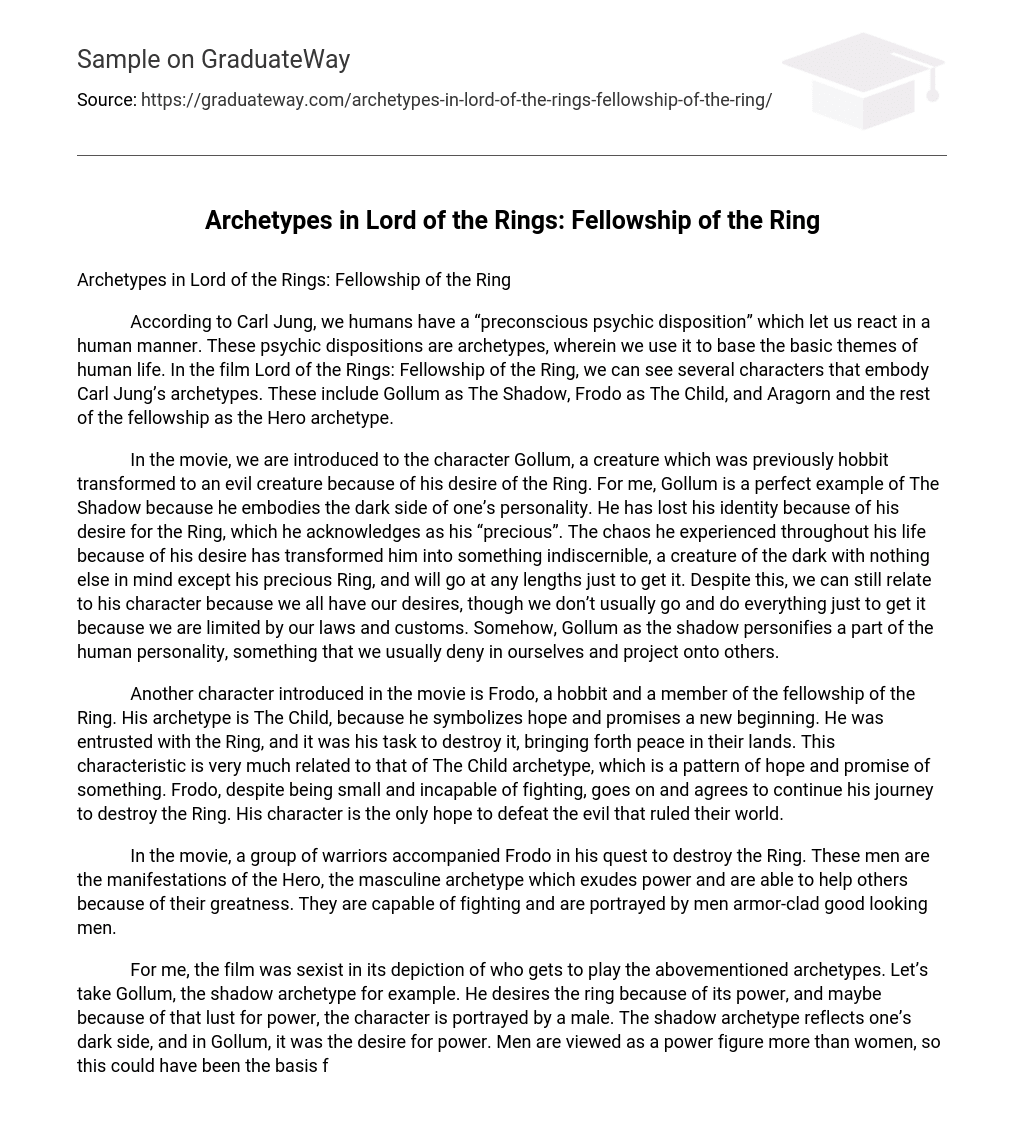According to Carl Jung, we humans have a “preconscious psychic disposition” which let us react in a human manner. These psychic dispositions are archetypes, wherein we use it to base the basic themes of human life. In the film Lord of the Rings: Fellowship of the Ring, we can see several characters that embody Carl Jung’s archetypes. These include Gollum as The Shadow, Frodo as The Child, and Aragorn and the rest of the fellowship as the Hero archetype.
In the movie, we are introduced to the character Gollum, a creature which was previously hobbit transformed to an evil creature because of his desire of the Ring. For me, Gollum is a perfect example of The Shadow because he embodies the dark side of one’s personality. He has lost his identity because of his desire for the Ring, which he acknowledges as his “precious”. The chaos he experienced throughout his life because of his desire has transformed him into something indiscernible, a creature of the dark with nothing else in mind except his precious Ring, and will go at any lengths just to get it. Despite this, we can still relate to his character because we all have our desires, though we don’t usually go and do everything just to get it because we are limited by our laws and customs. Somehow, Gollum as the shadow personifies a part of the human personality, something that we usually deny in ourselves and project onto others.
Another character introduced in the movie is Frodo, a hobbit and a member of the fellowship of the Ring. His archetype is The Child, because he symbolizes hope and promises a new beginning. He was entrusted with the Ring, and it was his task to destroy it, bringing forth peace in their lands. This characteristic is very much related to that of The Child archetype, which is a pattern of hope and promise of something. Frodo, despite being small and incapable of fighting, goes on and agrees to continue his journey to destroy the Ring. His character is the only hope to defeat the evil that ruled their world.
In the movie, a group of warriors accompanied Frodo in his quest to destroy the Ring. These men are the manifestations of the Hero, the masculine archetype which exudes power and are able to help others because of their greatness. They are capable of fighting and are portrayed by men armor-clad good looking men.
For me, the film was sexist in its depiction of who gets to play the abovementioned archetypes. Let’s take Gollum, the shadow archetype for example. He desires the ring because of its power, and maybe because of that lust for power, the character is portrayed by a male. The shadow archetype reflects one’s dark side, and in Gollum, it was the desire for power. Men are viewed as a power figure more than women, so this could have been the basis for the bias in the portrayal of the archetype. Another typical sexist depiction of the archetype is in the Hero, which is usually reserved for males: good-looking, well-sculpted body, and adept fighters. The Hero archetype is a protector, and males have always been viewed as the ones more capable of protecting others, so that’s how it was portrayed in the film.
For me, the film was not racist in depicting the characters that get to play the archetypes. It’s because it is set in the fantasy world of middle-earth, where humans co-existed with other creatures like elves, dwarves, wizards, orcs, hobbits, and a lot more. However, the humans in the film were mostly whites, probably because of the timeline that was set in Medieval Europe. It was mostly a world of make believe, so if there would be racism in the film, it won’t be about blacks or whites, it would be about humans or dwarves or elves or a lot more.
For me, the movie was able to effectively tell the story about the Fellowship of the Ring. This could be attributed to the good casting of characters and their effective portrayal of certain their roles. If I were to base my opinion about the film on the portrayal of archetypes, I would say that each of the characters chosen to play Gollum or Frodo or any of the fellowship, are really suited to play the archetype that they are. If ever it would be changed or adjusted in order to eliminate sexism or the bias towards male characters in the film, I would say that it could affect the film in a sense that it would alter the message it was conveying. As I saw it, it was set on the time of Kings and ruthless men, and women were confined to housework instead of battle. If this is the case, then I could safely conclude that the portrayal of different archetypes in the film Lord of the Rings: Fellowship of the Ring were appropriate for the setting and the story, and if anything would be changed to remove bias and other concerns, the film would have a different meaning. Every character and every role is effectively portrayed, and it was a great way to see and understand more about archetypes.





